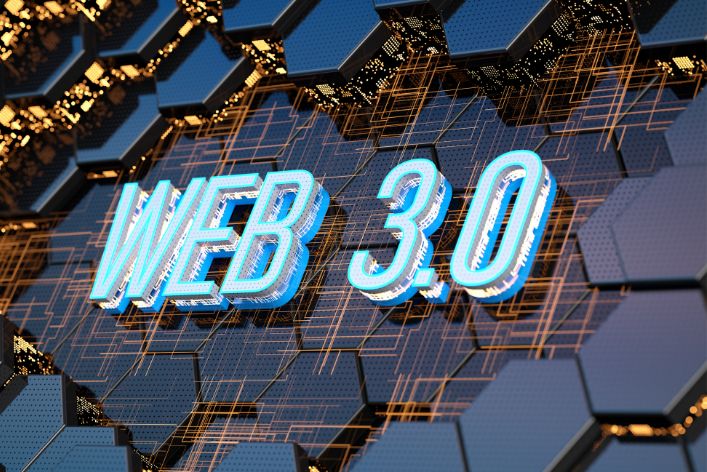Web 3.0 is all the rage nowadays, and for good reason.
Imagine a new kind of internet where all the content you consume is more personalized to you than ever before and truly understands everything you say, whether it be through text, voice, or other media.
The web is about to enter a new stage of its evolution.
Early adopters have dubbed it Web 3.0.
There may be a few early-stage Web 3.0 applications currently available.
However, their full potential cannot be realized until the new Internet is fully integrated into the web infrastructure.
But what exactly is Web 3.0, what will it look like, and how will it change our lives?
Definition of Web 3.0
Web 3.0 (Web3) is the third generation of web technologies.
The World Wide Web, commonly referred to as the Web, serves as the basic building block of the Internet by offering website and application services.
There isn’t a single accepted definition of Web 3.0 because it is continually changing and being defined.
However, Web 3.0 will heavily emphasize decentralized applications and utilize blockchain-based technology.
Artificial intelligence (AI) and machine learning will both be used in Web 3.0 to enable smarter, more adaptive applications.
The idea of a semantic web is another element that is included in the evolving definition of Web 3.0.
Web inventor Tim Berners-Lee is one of many who has pushed for the web to incorporate semantic technologies.
It took over ten years to move from the first web, Web 1.0, to Web 2.0, and it’s anticipated that Web 3.0 will take just as long, if not longer, to implement and transform the web completely.
Innovative Tech Solutions, Tailored for You
Our leading tech firm crafts custom software, web & mobile apps, designed with your unique needs in mind. Elevate your business with cutting-edge solutions no one else can offer.
Start NowIf the direction of change is followed from Web 1.0, a static information provider where users read websites but infrequently interacted with them, to Web 2.0, an interactive and social web enabling user collaboration, it can be assumed that Web 3.0 will alter both how websites are created and how users interact with them.
Read: All You Need To Know About Cryptocurrency

Features of Web 3.0
Although Web 3.0 has a few distinguishing characteristics, there is still no accepted definition of it.
Decentralization
This is a fundamental concept of Web 3.0.
In Web 2.0, computers search for data that is kept at a fixed location, typically on a single server, using HTTP in the form of distinct web addresses.
Information might be stored simultaneously in numerous locations and become decentralized with Web 3.0 since it would be found based on its content rather than a single location.
This would give individuals more power by dismantling the enormous databases that internet goliaths like Meta and Google presently maintain.
Through decentralized data networks, consumers will be able to sell the data produced by various and powerful computing resources, such as mobile phones, desktop computers, appliances, automobiles, and sensors, while still maintaining ownership control.
Connectivity and ubiquity
With Web 3.0, material and information are more connected and widely available, accessible by numerous applications, and more commonplace items are becoming web-connected.
One such gadget is the Internet of Things.
Trustless and permissionless
Web 3.0 will be trustless (i.e., the network will allow users to connect directly without going via a trusted intermediary) and permissionless in addition to being decentralized and built on open-source software (meaning that anyone can participate without authorization from a governing body).
As a result, Web 3.0 applications—also known as dApps—will operate on blockchains, decentralized peer-to-peer networks, or a hybrid of the two.
Artificial intelligence (AI) and machine learning
Web 3.0 will enable computers to comprehend information similarly to humans by using technologies based on semantic web principles and natural language processing.
Web 3.0 will also make use of machine learning, a subset of artificial intelligence (AI) that mimics human learning by using data and algorithms, gradually improving its accuracy.
Instead of targeted advertising, which makes up the majority of present efforts, these capabilities will enable computers to deliver faster and more relevant outcomes in various fields, such as medical development and new materials.
Read: Differences and Similarities Between Cryptocurrency Tokens and Coins
The Advantages of Web 3.0 over its Predecessors
User data won’t be under control in Web 3.0 because intermediaries are no longer necessary.
This reduces the possibility of corporate or governmental censorship and the potency of denial-of-service (DoS) assaults.
As more products are connected to the internet, larger databases provide algorithms with more data to analyze.
This will enable them to provide users with information that is more precisely matched to their needs.
Prior to Web 3.0, it was challenging to locate the most accurate result on search engines.
However, over time, they have become better at identifying semantically relevant results based on search context and data.
Web browsing becomes more practical as a result, making it easier for everyone to find the precise information they need.
For websites and web apps to provide a great user experience, customer service is essential.
Seamless API Connectivity for Next-Level Integration
Unlock limitless possibilities by connecting your systems with a custom API built to perform flawlessly. Stand apart with our solutions that others simply can’t offer.
Get StartedThe enormous costs, however, prevent many prosperous web companies from scaling their customer service operations.
Using intelligent chatbots that can converse with multiple customers at once, made possible by Web 3.0, users can have better interaction with support staff.
Read: Is It Worth Buying an NFT Today?

How Does It Work?
With our guiding principles established, we can start examining how certain Web3 development features are meant to accomplish these objectives.
- Ownership of data: When you utilize a site like Facebook or Youtube, these businesses collect, own, and profit from the data you provide. Your data is stored on your cryptocurrency wallet in web3. On web3, you’ll interact with apps and communities through your wallet, and when you log off, you’ll take your data with you. Since you are the owner of the data, you may theoretically choose whether to monetize it.
- Democracy: In web 3.0, apps will be managed by independent, decentralized groups. As a result, decisions are no longer made by a centralized authority but rather by users who own governance tokens, which may be acquired by participating in the maintenance of these decentralized programs or by purchasing them.
Realistically, Web 3.0 won’t take the place of Web 2.0, at least not anytime soon.
It will most likely develop concurrently with Web 2.0.
Simply put, it gives customers additional choices.
Go to Facebook and use it if you want to.
Use a decentralized system that rewards involvement if that’s what you want to do.
- Pseudonymity: Your wallet is designed with privacy, much like data ownership. Your wallet serves as your identification on web3, which makes it difficult to connect it to your actual identity. Therefore, even if someone can observe the activity of a wallet, they won’t be able to identify your wallet.
Some services help customers connect to their cryptocurrency wallets used for illegal behaviour.
However, your identity is concealed for daily use.
Read: What You Are to Know About NFTs
Conclusion
Web 3.0 promises a more personalized, decentralized, and user-controlled internet experience.
By integrating blockchain, AI, and machine learning, it offers new ways to interact with digital spaces.
This empowers users with greater control over their data and online activities.
While Web 3.0 won’t replace Web 2.0 immediately, it provides a complementary evolution, giving users more freedom and privacy.
As this new web gradually unfolds, it’s essential to stay informed and ready to embrace the changes it brings.
It offers a glimpse into the future of the internet, where the user truly holds the power.
Before You Go…
Hey, thank you for reading this blog post to the end. I hope it was helpful. Let me tell you a little bit about Nicholas Idoko Technologies.
We help businesses and companies build an online presence by developing web, mobile, desktop, and blockchain applications.
We also help aspiring software developers and programmers learn the skills they need to have a successful career.
Take your first step to becoming a programming expert by joining our Learn To Code academy today!
Be sure to contact us if you need more information or have any questions! We are readily available.











